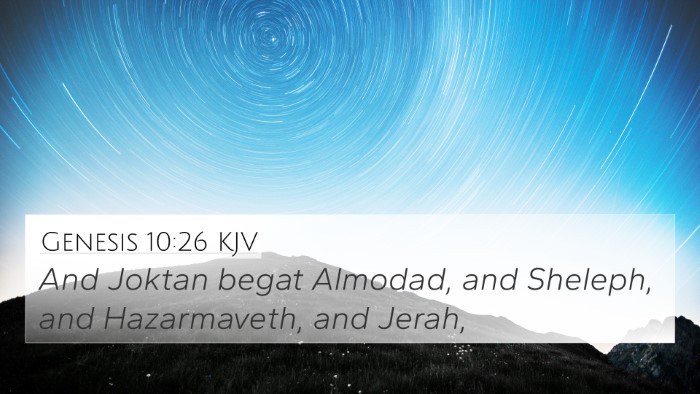Understanding 1 Chronicles 1:20
1 Chronicles 1:20 states:
"These are the children of Shem; Elam, and Asshur, and Arphaxad, and Lud, and Aram."
This verse serves as part of the genealogical record in the book of Chronicles, which aims to establish the lineage and tribal heritage of the Israelites. Below is a summary of interpretations from various public domain commentaries, emphasizing the significance of the names mentioned and their implications in biblical history.
Commentary Insights
Matthew Henry’s Commentary
Henry emphasizes the importance of genealogy as a means of tracing God's covenant through history. He portrays Shem as a pivotal figure, given his role in the post-flood world, and notes that each descendant represents various nations significant in the biblical narrative. He highlights:
- Elam: regarded as the ancestor of the Elamites, linked to Persia and a future enemy of Israel.
- Asshur: considered the progenitor of the Assyrians, who later played a crucial role in Israel’s history.
- Arphaxad: seen as a direct link to Abraham, signifying the continuation of God’s promise to the patriarchs.
- Lud: often associated with the Ludim, noted as probably linked to ancient Egyptians.
- Aram: recognized for his descendants who formed the Arameans, significant for both their cultural and political influences in the region.
Albert Barnes' Notes
Barnes presents a detailed exploration of each name, providing context to their historical and geographical significance. He asserts:
- Elam: Barnes notes the prominence of the Elamites in Babylonian history, indicating geopolitical influences.
- Asshur: highlights Assyria's rise and its role as a dominant power in biblical accounts.
- Arphaxad: connects the name with the lineage that leads to significant biblical characters in later scriptures.
- Lud: comments on the connection to the people of Lud, often allied with the Egyptians.
- Aram: emphasizes the cultural and linguistic legacy of the Arameans in biblical texts.
Adam Clarke's Commentary
Clarke presents an analytical approach to this genealogy, emphasizing its importance for Jews understanding their identity. He indicates that:
- Elam: reflects the historical connotation of the name as a land seen in various biblical narratives.
- Asshur: points to the people that invaded and exiled Israel, noting the long-standing tensions.
- Arphaxad: is crucial for understanding the messianic lineage, as it connects with Abraham.
- Lud: presents an interesting study of migration and cultural diffusion in biblical times.
- Aram: lauded for its linguistic contributions to the Old Testament.
Bible Cross-References
This verse connects to various other scriptures, enhancing its meaning and allowing for a rich theological understanding:
- Genesis 10:22: A comprehensive genealogy of the sons of Noah can provide cross-contextual insights.
- Genesis 11:10-26: Traces the lineage further, establishing connections to Abraham.
- Isaiah 11:11: Mentions the remnant of Israel, emphasizing the prophetic ties to these nations.
- Acts 2:9-11: References the Parthians and Medes concerning the descendants of Shem.
- Jeremiah 25:25: Lists nations, including Assyria, playing a role in biblical prophecies.
- Ezekiel 30:4: Discusses Egypt and its relationship with neighboring nations, including Lud.
- Romans 9:5: Connects to the lineage of Christ through Abraham, tying back to Arphaxad.
Thematic Bible Verse Connections
The genealogy found in 1 Chronicles 1:20 also points to larger themes within scripture:
- Divine Sovereignty: The mapping of genealogy illustrates God's sovereign plan throughout history.
- Identity and Heritage: Understanding ancestry is crucial for the Israelites, reflecting their unique covenant relationship with God.
- Prophetic Fulfillment: Recognizing the importance of genealogies in the unfolding of prophetic words regarding the Messiah.
- Cultural Impact: The referenced nations illustrate a rich tapestry of cultural dynamics and biblical interactions.
Conclusion
In conclusion, 1 Chronicles 1:20 not only serves as a simple genealogical reference but encapsulates rich theological significance. Through careful cross-referencing with other scriptures and thorough examination from various commentaries, we see the intricate web of biblical history that links Shem’s lineage to broader themes of God's plan, identity, prophetic glimpses, and cultural dimensions within the scriptural narrative.



